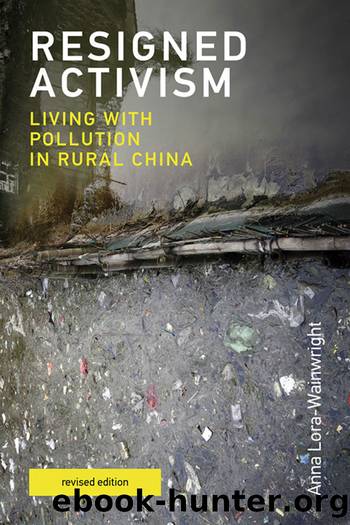Resigned Activism, revised edition by Anna Lora-Wainwright

Author:Anna Lora-Wainwright [Lora-Wainwright, Anna]
Language: eng
Format: epub
Publisher: MIT Press
Published: 2021-02-17T00:00:00+00:00
Figure 4.7âLocals maintaining alternative livelihoods: tobacco growing, 2010.
The severity of pollution in Qiancun has been documented since 2000 by a team of medical geographers from the Institute of Geographic Sciences and Natural Resources Research (IGSNRR, Chinese Academy of Sciences). During an early fieldtrip in 2000, researchers were told that water used for drinking, washing vegetables, clothes, and household implements was polluted, and that some water sources had become dry, forcing villagers to seek alternative water sources. Villagers also told researchers that fish and ducks had died, and they raised concerns about water pollution with county authorities. The research team carried out pilot studies on levels of heavy metals, including lead, in the soil, water, local crops (including staple foods such as rice and vegetables such as peppers), and in the hair and blood of local residents. Follow-up studies since 2009 have been supported by FORHEAD grants (see below). While data collected is based on limited sampling, and therefore cannot provide a complete picture, it nevertheless offers some insights on the levels of damage and exposure.
Research carried out by IGSNRR highlighted several pathways of exposure to heavy metals pollution. It showed that the most significant path of exposure is from rice, while water and vegetables play a much less prominent role (see, for instance, Zhang 2011). It suggested that lead content in the surface soil in paddy fields seriously exceeded national safety levels (Li, Wang, Yang, and Li 2005; Zhang 2011), though this may not be used to extrapolate levels of lead in the crops in any straightforward way (N. Chen 2013). National standards of environmental quality for the soil issued in 1995 (Ministry of Environmental Protection 1995) recommend lead content below 250 μg/g,5 but in Qiancun lead content in the majority of sites tested exceeded this figure fivefold, and in one case it almost reached 2500 μg/g, with cadmium (Cd), mercury (Hg) and arsenic (As) also in excess (Li 2012).6 Soil pollution, however, varies in different areas of the village depending on proximity to mining, slag heaps, tailing ponds, and water flows (Holdaway and Husain 2014).
Lead content in rice in some fields also exceeded the national food safety standard, with lead content up to 2.2 μg/g, well above the recommended maximum of 0.2 μg/g. Cadmium, mercury, and arsenic were also in excess (Y. Li 2012). Effects on crops may also be uneven, depending on the type of rice grown, the water sources used, and the location and soil composition of the fields in terms of soil pH, quality, and moisture (Holdaway and Husain 2014). Indeed, the most recent tests showed that levels of heavy metals might have decreased since the closing of local mines (N. Chen 2013). However, some of the other effects of mining on the environmentâsuch as the lowering of groundwater levels and consequent drying out of former paddy fieldsâare irreversible.
Mining affected groundwater levels and quality by reducing the available amount of drinking water and polluting it. Most villagers believed that the quality of surface water, such as in the local stream and ponds, declined as a result of mining.
Download
This site does not store any files on its server. We only index and link to content provided by other sites. Please contact the content providers to delete copyright contents if any and email us, we'll remove relevant links or contents immediately.
Islands of Abandonment by Cal Flyn(612)
Where the Deer and the Antelope Play by Nick Offerman(525)
A Zero Waste Life by Anita Vandyke(437)
Second Nature by Nathaniel Rich(406)
A Wild Idea by Jonathan Franklin(392)
How to Read the Weather by Storm Dunlop(380)
Tomorrow's Economy by Per Espen Stoknes(376)
This Is Water by David Foster Wallace(341)
The Redemption of Wolf 302 by Rick McIntyre(314)
The Essential Wilderness Navigator by David Seidman & Paul Cleveland(306)
A Perfect Planet by Huw Cordey(306)
The Reign of Wolf 21 by Rick McIntyre(303)
Wilderness Essays by John Muir(290)
The Emergence of Numerical Weather Prediction Richardson Dream by Peter Lynch(289)
Wildwood: A Journey Through Trees by Roger Deakin(287)
Pig Tales: An Omnivore's Quest for Sustainable Meat by Barry Estabrook(286)
Weather Forecasting for Photographers by Stanley Rose & Stanley Rose(241)
Clouds by Richard Hamblyn(239)
The Bears of Brooks Falls by Michael Fitz(230)
